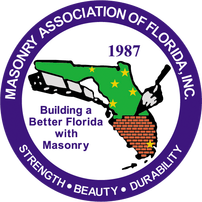|
I am always hearing about the Perm Rating of walls and wanted to know if perm rating of masonry walls is something that is a big concern in Florida? The Perm rating of stucco is a red herring. Climate zones 1 and 2 strictly LIMIT the perm rating of vapor barriers because you don’t want to trap moisture in the wall. Standard stucco is a Class III Vapor Barrier with a perm rating between 5 and 10 which would also make it a Vapor Permeable which is better yet in Florida. Stucco is accepted as a suitable weather barrier throughout the code – and that is what you are looking for in climate zones 1 and 2 – a weather barrier – not a vapor barrier. Check out 1405.3.1 and 1405.3.2. The code is RESTRICTING the perm rating of vapor barriers – not requiring low perm barriers. Stucco, and CMU, serves as a good weather and air barrier. If you are keen on low perm vapor barriers then move up North. We don’t need them in Florida.
0 Comments
Correct code to use to certify CMU for a project designed under a previous edition of the FL Building Code. Our project calls for 2 hr rated block and was permitted under the 2010 FL Building Code. The engineer is not approving our submittal because the manufacturer is certifying the block under the 5th Edition, 2014 FL Building Code. He is saying that the block must be certified and tested under the 2010 code? What is going on? Your reviewing engineer is being a bit obsessive over a moot point. Table 721.3.2 in the 2007 FBC with 2009 revisions is EXACTLY the same table as 721.3.2 in the 2010 FBC which is EXACTLY the same table as 722.3.2 in the 5th Ed FBC which is EXACTLY the same table as 722.3.2 in the current 6th Ed FBC. And I do mean EXACTLY the same table. There have been no changes in this table for the past 30 years or more. 4 inch Eq Thickness of limestone agg gets you a 2 hour rating in 2007 and in 2019 - period, end of story. Additionally, the C140 testing procedures have remained exactly the same over the same 30+ years. The project was permitted under the 2010 FBC and thus is ALLOWED to be constructed under the requirements that governed at the time it was designed and reviewed (so you are not required to completely redesign the project under the current codes). It is my understanding that this does NOT mean that everyone supplying materials to the job have to climb into a time machine and retro backwards 10 years to resurrect and construct the job by historical - and out of date - standards.
That being said, your standards in the certification are not correct either way (neither 2010 or 2017. My view is that you should be testing and certifying your product under the current code (2017) and that the engineer of record should accept the current codes and standards governing construction in Florida. The question is moot because the governing procedures, and tables, have not changed. |
Authors:

Categories
All
Archives
June 2022
|
Masonry Resources |
MAF Websites |
Masonry Association of Florida, Inc. |PO Box 24474 , Fort Lauderdale, FL 33307
Copyright © 2017. All Rights Reserved.
Sitemap
Sitemap

 RSS Feed
RSS Feed
